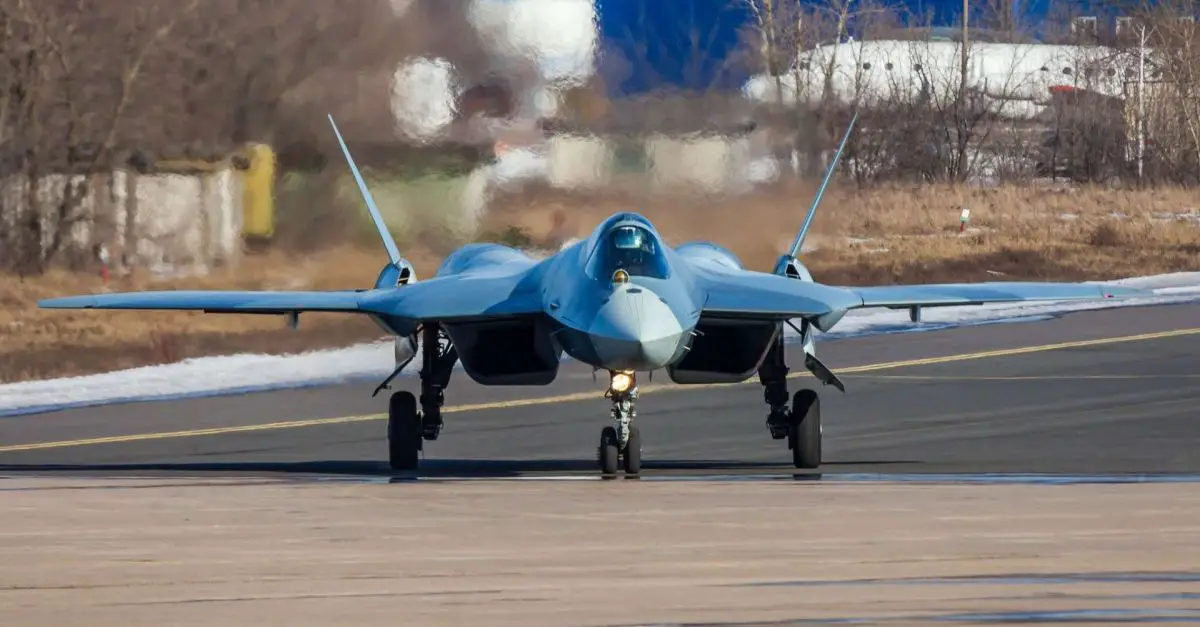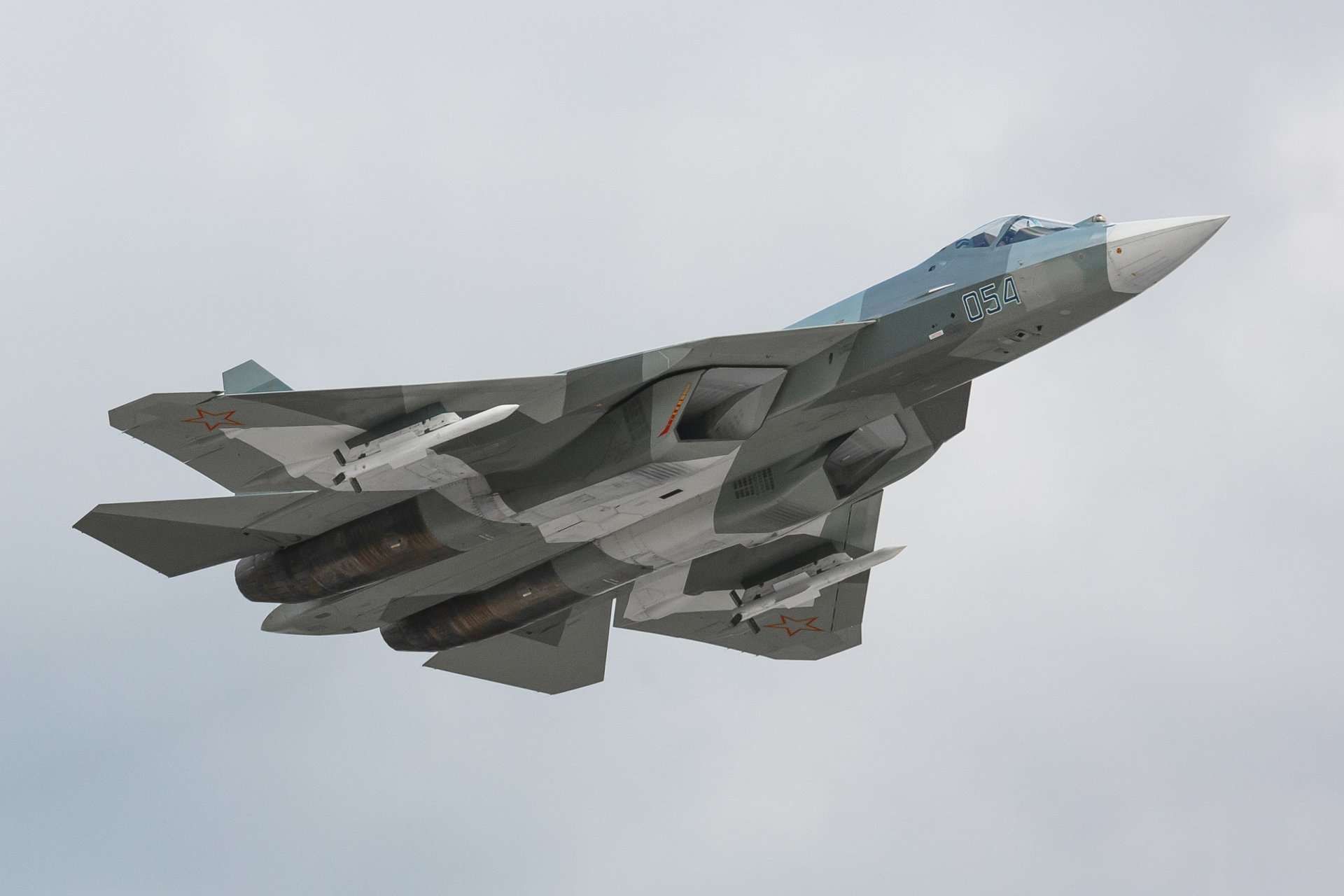Breaking news
Russian Air Force’s Su-57 Felon stealth fighter strikes key infrastructure in Ukraine.
According to Army Inform on 26 April 2024, Major Ilya Yevlash, spokesman for the Air Force of the Ukrainian Armed Forces, recently provided information on the use of the Sukhoi Su-57 Felon stealth fighter by the Russian Air Force in Ukraine. Yevlash underscored that while the Su-57 is deployed for attacks on Ukraine, Russian forces are cautious about its proximity to Ukrainian air defenses.
Follow Army Recognition on Google News at this link

As Russia's first aircraft designed with stealth technology, the Su-57 aims to replace the MiG-29 and Su-27 in Russian military service. (Picture source: Russian social media)
Describing the Su-57 as a 'rather expensive and unique rattle,' Yevlash hinted at its significance to the Russians without embellishing its role. The armament suite of the Su-57 includes the Kh-69 missile, believed to have been employed in recent attacks, such as the complete incapacitation of the Trypillia Thermal Power Plant on April 11, 2024. Situated near Kyiv, the Trypillia Thermal Power Plant serves as a critical infrastructure hub, providing electricity to the capital region and its environs. Its strategic significance heightened post-Chernobyl, stabilizing the national grid and compensating for the loss of power from the decommissioned nuclear plant, solidifying its status as one of Ukraine's most important thermal power stations, with its production of 1,800 MW.
On April 25, further military actions saw Russian forces targeting Ukrainian railway and logistics infrastructure. Strikes on Smila in Cherkasy Oblast and Balaklia in Kharkiv Oblast, reportedly conducted with Iskander-K missiles, inflicted damage, with civilians injured in the latter incident. Ukrainian military sources also reported the destruction of an unspecified cruise missile over Kryvyi Rih Raion, Dnipropetrovsk Oblast. Major Ilya Yevlash stated that this cruise missile, launched from a Su-57, traversed Ukrainian territory before reaching its target. Additionally, analysis from the Institute for the Study of War suggests a strategic shift by Russian forces towards targeting transportation infrastructure, potentially aimed at impeding Ukrainian forces' capabilities and disrupting the distribution of resources along the frontline, which includes military aid from Western allies.
The Sukhoi Su-57, also known as the Felon, is a twin-engine stealth multirole fighter developed by Sukhoi as part of the PAK FA program initiated in 1999. As Russia's first aircraft designed with stealth technology, the Su-57 aims to replace the MiG-29 and Su-27 in Russian military service. Combining stealth, supermaneuverability, supercruise, integrated avionics, and a large payload capacity, it is intended for aerial combat as well as ground and maritime strike missions. Despite initial delays and technical issues, including a crash in 2019, the first Su-57 entered service with the Russian Aerospace Forces in December 2020. Development faced challenges such as structural redesigns and procurement setbacks, leading to scaled-back production plans. However, serial production began in 2019, with 32 aircraft built by 2023.
The Su-57's design emphasizes supermaneuverability across all axes, ample internal payload capacity for multirole use, and advanced sensor systems, including an active phased-array radar, all integrated to achieve high levels of automation. Drawing inspiration from the Lockheed Martin F-22, Sukhoi tailored the Su-57 to address perceived limitations, such as insufficient payload capacity and maneuverability. The aircraft features a wide blended wing body fuselage with widely spaced engines, all-moving horizontal and vertical stabilizers, and canted vertical stabilizers for stealth. Thrust vectoring and leading-edge root extensions enhance maneuverability, while extensive use of composites reduces weight and preserves stealth shaping. With substantial internal payload capacity distributed across main and side weapons bays, the Su-57 minimizes drag from external stores and maintains stealth characteristics.

In air-to-air engagements, the Su-57 carries four beyond-visual-range missiles in its main bays and two short-range missiles in the side bays. (Picture source: Russian social media)
Drawing from design principles akin to other stealth fighters such as the F-22, the Su-57 prioritizes aligning planform edges to reduce its radar cross-section (RCS), involving meticulous angling of leading and trailing edges of wings, control surfaces, and serrated edges of skin panels. Internal weapons bays conceal armaments, while recessed antennas maintain the aircraft's stealth profile. Radar absorbent material (RAM) coatings are utilized to absorb radar emissions and minimize reflection. Notably, the engine face's significant RCS contribution is addressed by coating inlet duct walls with RAM and employing partial serpentine ducts to obscure engine components. Additionally, the canopy is coated with radar-absorbing layers to reduce cockpit radar return and provide protection against ultraviolet and thermal radiation. These stealth features, coupled with stringent production tolerances, have significantly reduced the Su-57's RCS, estimated to be thirty times smaller than that of the Su-27.
The internal weapons bays of the Su-57 employ two types of ejection launchers: UVKU-50L for missiles weighing up to 300 kg and UVKU-50U for ordnance up to 700 kg, while the side bays use VPU-50 launch rails. In air-to-air engagements, the Su-57 carries four beyond-visual-range missiles in its main bays and two short-range missiles in the side bays. Its primary medium-range missile is the R-77M, an upgraded variant with an AESA seeker, dual-pulse motor, and conventional rear fins, whereas the short-range missile is the R-74M2, an infrared-homing variant. For ground targets, the Su-57 can employ precision-guided bombs like the KAB-250 or KAB-500 in its main bays, along with air-to-ground missiles such as the Kh-38M and anti-ship missiles like the Kh-35U. It can also carry stores on its six external hardpoints for missions not necessitating stealth. Like the Su-27, the aircraft is armed with a 30 mm GSh-30-1 autocannon, effective against both aerial and surface targets, mounted internally near the right LEVCON root.
The Su-57 is equipped with two Saturn AL-41F1 afterburning turbofan engines, each capable of generating 88.3 kN (19,900 lbf) of thrust in dry mode, 142.2 kN (32,000 lbf) with afterburner, and 147.1 kN (33,100 lbf) in emergency mode. Allowing for a maximum speed of Mach 2 and a supercruise speed of Mach 1.3, these engines are integrated with the aircraft's flight control system, featuring full authority digital engine control (FADEC) for enhanced maneuverability and handling. Thrust vector control (TVC) allows the aircraft to produce thrust vectoring moments about all three axes, enabling agile maneuvering. With a range of 3,500 km in subsonic flight and a supersonic range of 1,500 km, the Su-57 can reach a service ceiling of 20,000 m (66,000 ft). Additionally, the Su-57 incorporates variable intake ramps for supersonic efficiency and retractable mesh screens to prevent engine damage from foreign object debris ingestion. Future variants, such as the planned Su-57M, are slated to be equipped with the Izdeliye 30 engine, also designated as AL-51F-1, promising improved performance, reliability, and reduced radar and infrared signature.
Defense News February 2024




















